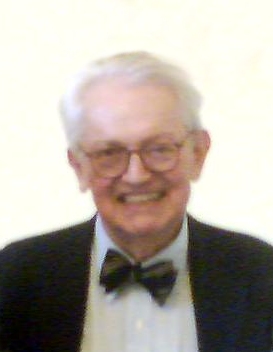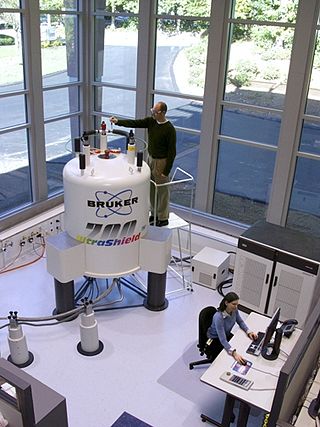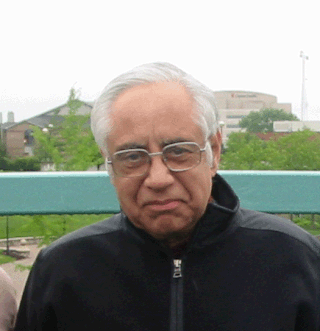Related Research Articles
The nuclear Overhauser effect (NOE) is the transfer of nuclear spin polarization from one population of spin-active nuclei to another via cross-relaxation. A phenomenological definition of the NOE in nuclear magnetic resonance spectroscopy (NMR) is the change in the integrated intensity of one NMR resonance that occurs when another is saturated by irradiation with an RF field. The change in resonance intensity of a nucleus is a consequence of the nucleus being close in space to those directly affected by the RF perturbation.
Dynamic nuclear polarization (DNP) results from transferring spin polarization from electrons to nuclei, thereby aligning the nuclear spins to the extent that electron spins are aligned. Note that the alignment of electron spins at a given magnetic field and temperature is described by the Boltzmann distribution under the thermal equilibrium. It is also possible that those electrons are aligned to a higher degree of order by other preparations of electron spin order such as: chemical reactions, optical pumping and spin injection. DNP is considered one of several techniques for hyperpolarization. DNP can also be induced using unpaired electrons produced by radiation damage in solids.

Nuclear magnetic resonance spectroscopy, most commonly known as NMR spectroscopy or magnetic resonance spectroscopy (MRS), is a spectroscopic technique to observe local magnetic fields around atomic nuclei. This spectroscopy is based on the measurement of absorption of electromagnetic radiations in the radio frequency region from roughly 4 to 900 MHz. Absorption of radio waves in the presence of magnetic field is accompanied by a special type of nuclear transition, and for this reason, such type of spectroscopy is known as Nuclear Magnetic Resonance Spectroscopy. The sample is placed in a magnetic field and the NMR signal is produced by excitation of the nuclei sample with radio waves into nuclear magnetic resonance, which is detected with sensitive radio receivers. The intramolecular magnetic field around an atom in a molecule changes the resonance frequency, thus giving access to details of the electronic structure of a molecule and its individual functional groups. As the fields are unique or highly characteristic to individual compounds, in modern organic chemistry practice, NMR spectroscopy is the definitive method to identify monomolecular organic compounds.

Solid-state NMR (ssNMR) spectroscopy is a technique for characterizing atomic level structure in solid materials e.g. powders, single crystals and amorphous samples and tissues using nuclear magnetic resonance (NMR) spectroscopy. The anisotropic part of many spin interactions are present in solid-state NMR, unlike in solution-state NMR where rapid tumbling motion averages out many of the spin interactions. As a result, solid-state NMR spectra are characterised by larger linewidths than in solution state NMR, which can be utilized to give quantitative information on the molecular structure, conformation and dynamics of the material. Solid-state NMR is often combined with magic angle spinning to remove anisotropic interactions and improve the resolution as well as the sensitivity of the technique.
Carbon-13 (C13) nuclear magnetic resonance is the application of nuclear magnetic resonance (NMR) spectroscopy to carbon. It is analogous to proton NMR and allows the identification of carbon atoms in an organic molecule just as proton NMR identifies hydrogen atoms. 13C NMR detects only the 13
C
isotope. The main carbon isotope, 12
C
does not produce an NMR signal. Although ca. 1 mln. times less sensitive than 1H NMR spectroscopy, 13C NMR spectroscopy is widely used for characterizing organic and organometallic compounds, primarily because 1H-decoupled 13C-NMR spectra are more simple, have a greater sensitivity to differences in the chemical structure, and, thus, are better suited for identifying molecules in complex mixtures. At the same time, such spectra lack quantitative information about the atomic ratios of different types of carbon nuclei, because nuclear Overhauser effect used in 1H-decoupled 13C-NMR spectroscopy enhances the signals from carbon atoms with a larger number of hydrogen atoms attached to them more than from carbon atoms with a smaller number of H's, and because full relaxation of 13C nuclei is usually not attained, and the nuclei with shorter relaxation times produce more intense signals.
Nuclear magnetic resonance spectroscopy of proteins is a field of structural biology in which NMR spectroscopy is used to obtain information about the structure and dynamics of proteins, and also nucleic acids, and their complexes. The field was pioneered by Richard R. Ernst and Kurt Wüthrich at the ETH, and by Ad Bax, Marius Clore, Angela Gronenborn at the NIH, and Gerhard Wagner at Harvard University, among others. Structure determination by NMR spectroscopy usually consists of several phases, each using a separate set of highly specialized techniques. The sample is prepared, measurements are made, interpretive approaches are applied, and a structure is calculated and validated.
Two-dimensional nuclear magnetic resonance spectroscopy is a set of nuclear magnetic resonance spectroscopy (NMR) methods which give data plotted in a space defined by two frequency axes rather than one. Types of 2D NMR include correlation spectroscopy (COSY), J-spectroscopy, exchange spectroscopy (EXSY), and nuclear Overhauser effect spectroscopy (NOESY). Two-dimensional NMR spectra provide more information about a molecule than one-dimensional NMR spectra and are especially useful in determining the structure of a molecule, particularly for molecules that are too complicated to work with using one-dimensional NMR.
Herbert Sander Gutowsky was an American chemist who was a professor of chemistry at the University of Illinois Urbana-Champaign. Gutowsky was the first to apply nuclear magnetic resonance (NMR) methods to the field of chemistry. He used nuclear magnetic resonance spectroscopy to determine the structure of molecules. His pioneering work developed experimental control of NMR as a scientific instrument, connected experimental observations with theoretical models, and made NMR one of the most effective analytical tools for analysis of molecular structure and dynamics in liquids, solids, and gases, used in chemical and medical research, His work was relevant to the solving of problems in chemistry, biochemistry, and materials science, and has influenced many of the subfields of more recent NMR spectroscopy.
Carbon satellites in physics and spectroscopy, are small peaks that can be seen shouldering the main peaks in the nuclear magnetic resonance (NMR) spectrum. These peaks can occur in the NMR spectrum of any NMR active atom where those atoms adjoin a carbon atom. However, Carbon satellites are most often encountered in proton NMR.

Charles Pence Slichter was an American physicist, best known for his work on nuclear magnetic resonance and superconductivity.
Raymond Freeman FRS was a British chemist and professor at Jesus College, Cambridge who made important contributions to NMR spectroscopy.

Nuclear magnetic resonance (NMR) is a physical phenomenon in which nuclei in a strong constant magnetic field are perturbed by a weak oscillating magnetic field and respond by producing an electromagnetic signal with a frequency characteristic of the magnetic field at the nucleus. This process occurs near resonance, when the oscillation frequency matches the intrinsic frequency of the nuclei, which depends on the strength of the static magnetic field, the chemical environment, and the magnetic properties of the isotope involved; in practical applications with static magnetic fields up to ca. 20 tesla, the frequency is similar to VHF and UHF television broadcasts (60–1000 MHz). NMR results from specific magnetic properties of certain atomic nuclei. Nuclear magnetic resonance spectroscopy is widely used to determine the structure of organic molecules in solution and study molecular physics and crystals as well as non-crystalline materials. NMR is also routinely used in advanced medical imaging techniques, such as in magnetic resonance imaging (MRI).

Jean Louis Charles Jeener was a Belgian physical chemist and physicist, well known for his experimental and theoretical contributions to spin thermodynamics in solids and for his invention of Two-dimensional nuclear magnetic resonance spectroscopy. He was born in Brussels in 1931, son of Raymond Jeener (biologist) and Hélène Massar. He was married to Françoise Henin.

Geoffrey Bodenhausen is a French chemist specializing in nuclear magnetic resonance, being highly cited in his field. He is a Corresponding member of the Royal Netherlands Academy of Arts and Sciences and a Fellow of the American Physical Society. He is professeur émérite at the Department of Chemistry at the École Normale Supérieure (ENS) in Paris and professeur honoraire at the Laboratory of Biomolecular Magnetic Resonance of the École Polytechnique Fédérale de Lausanne (EPFL). He is a member of the editorial board of the journal Progress in Nuclear Magnetic Resonance Spectroscopy. He is the chair of the editorial board of the journal Magnetic Resonance.
Myer Bloom, was a Canadian physicist, specializing in the theory and applications of Nuclear magnetic resonance.

Lucio Frydman is an Israeli chemist whose research focuses on magnetic resonance imaging (MRI), nuclear magnetic resonance (NMR) and solid-state NMR. He was awarded the 2000 Günther Laukien Prize, the 2013 Russell Varian Prize and the 2021 Ernst Prize. He is Professor and Head of the Department of Chemical and Biological Physics at the Weizmann Institute of Science in Israel and Chief Scientist in Chemistry and Biology at the US National High Magnetic Field Laboratory in Tallahassee, Florida. He is a fellow of the International Society of Magnetic Resonance and of the International Society of Magnetic Resonance in Medicine. He was the Editor-in-Chief of the Journal of Magnetic Resonance (2011-2021).
Malcolm Harris Levitt is a British physical chemist and nuclear magnetic resonance (NMR) spectroscopist. He is Professor in Physical Chemistry at the University of Southampton and was elected a Fellow of the Royal Society in 2007.
Cynthia J. Jameson is an Emeritus Professor of Chemistry at the University of Illinois. She works on nuclear magnetic resonance spectroscopy and quantum chemistry. Jameson dedicated her academic career to supporting women scientists. She is a Fellow of the American Association for the Advancement of Science.

Anil Kumar is an Indian experimental physicist known for his work in the field of nuclear magnetic resonance spectroscopy. He is a professor at the Indian Institute of Science in Bangalore.

Alfred G. Redfield was an American physicist and biochemist. In 1955 he published the Redfield relaxation theory, effectively moving the practice of NMR or Nuclear magnetic resonance from the realm of classical physics to the realm of semiclassical physics. He continued to find novel magnetic resonance applications to solve real-world problems throughout his life.
References
- 1 2 3 4 5 6 7 The Russel Varian Prize and Lecture . Retrieved 12 December 2017.
{{cite book}}:|website=ignored (help) - ↑ "Guide to the Varian, Inc. Records". Online Archive of California. Stanford University Libraries. Retrieved 12 December 2017.
- ↑ "The Russel Varian Prize 2007". EUROMAR 2006. EUROMAR. Archived from the original on 28 August 2008. Retrieved 12 December 2017.
- ↑ "Agilent Completes Varian Acquisition". GenomeWeb. 17 May 2010. Retrieved 17 December 2017.
- ↑ Reisch, M.S. (2014). "Agilent to Exit NMR Business". Chemical & Engineering News. 92 (42): 11. doi:10.1021/cen-09242-notw9 . Retrieved 17 December 2017.
- ↑ "Russel Varian Prize 2002". EUROMAR Conference 2006. EUROMAR. Archived from the original on 30 March 2012. Retrieved 13 December 2017.
- ↑ "Russel Varian Prize 2004". EUROMAR Conference 2006. EUROMAR. Retrieved 13 December 2017.
- ↑ Hahn, E.L. (1950). "Spin Echoes". Physical Review. 80 (4): 580–594. Bibcode:1950PhRv...80..580H. doi:10.1103/PhysRev.80.580. S2CID 46554313.
- ↑ "Russel Varian Prize 2005". EUROMAR Conference 2006. EUROMAR. Retrieved 13 December 2017.
- ↑ Bloembergen, N.; Purcell, E.M.; Pound, R.V. (1947). "Nuclear Magnetic Relaxation". Nature. 160 (4066): 475–476. Bibcode:1947Natur.160..475B. doi:10.1038/160475a0. hdl: 1874/7413 . PMID 20265559. S2CID 4002836 . Retrieved 14 December 2017.
- ↑ "Russel Varian Prize 2006". EUROMAR Conference 2006. EUROMAR. Retrieved 13 December 2017.
- ↑ Waugh, J.S.; Wang, C.H.; Huber, L.M.; Vold, R.L. (1968). "Multiple-Pulse NMR Experiments". Journal of Chemical Physics. 48 (2): 662–670. Bibcode:1968JChPh..48..662W. doi: 10.1063/1.1668698 .
- ↑ Redfield, A.G. (1957). "On the Theory of Relaxation Processes". IBM Journal of Research and Development. 1: 19–31. doi:10.1147/rd.11.0019.
- ↑ "2008 Russell Varian Prize to Alex Pines". PinesLab. Lawrence Berkeley National Laboratory News Center. Retrieved 13 December 2017.
- ↑ Pines, A.; Gibby, M.G.; Waugh, J.S. (1972). "Proton-Enhanced Nuclear Induction Spectroscopy". Journal of Chemical Physics. 56 (4): 1776–1777. Bibcode:1972JChPh..56.1776P. doi:10.1063/1.1677439. S2CID 95376682.
- ↑ "Russell Varian Prize 2009 Laureate" (PDF). EUROMAR. Retrieved 13 December 2017.
- ↑ Overhauser, A.W. (1953). "Polarization of Nuclei in Metals". Physical Review. 92 (2): 411–415. Bibcode:1953PhRv...92..411O. doi:10.1103/PhysRev.92.411.
- ↑ Karplus, M. (1959). "Contact Electron-Spin Coupling of Nuclear Magnetic Moments". Journal of Chemical Physics. 30 (1): 11–15. Bibcode:1959JChPh..30...11K. doi:10.1063/1.1729860.
- ↑ "Announcement of the Russell Varian Prize 2011" (PDF). EUROMAR. Retrieved 13 December 2017.
- ↑ Morris, G.A. (1979). "Enhancement of Nuclear Magnetic Resonance Signals by Polarization Transfer". Journal of the American Chemical Society. 101 (3): 760–762. doi:10.1021/ja00497a058.
- ↑ Freeman, R.; Anderson, W.A. (1962). "Use of Weak Perturbing Radio-Frequency Fields in Nuclear Magnetic Double Resonance". Journal of Chemical Physics. 37 (9): 2053–2074. Bibcode:1962JChPh..37.2053F. doi:10.1063/1.1733426.
- ↑ Frydman, L.; Scherf, T.; Lupulescu, A. (2002). "The Acquisition of Multidimensional NMR Spectra within a Single Scan". Proceedings of the National Academy of Sciences of the USA. 99 (25): 15858–15862. Bibcode:2002PNAS...9915858F. doi: 10.1073/pnas.252644399 . PMC 138528 . PMID 12461169.
- ↑ "The Russell Varian Lecture and Prize" (PDF). EUROMAR. Retrieved 13 December 2017.
- ↑ Bax, A.; Mehlkopf, A.F.; Smidt, J. (1979). "Homonuclear Broadband Decoupled Absorption Spectra". Journal of Magnetic Resonance. 35 (1): 167–169. Bibcode:1979JMagR..35..167B. CiteSeerX 10.1.1.703.5487 . doi:10.1016/0022-2364(79)90088-X.
- ↑ "Major international honour for Professor of Physical Chemistry". University of Southampton. Retrieved 13 December 2017.
- ↑ Levitt, M.H.; Freeman, R. (1979). "NMR Population Inversion Using a Composite Pulse". Journal of Magnetic Resonance. 33 (2): 473–476. Bibcode:1979JMagR..33..473L. doi:10.1016/0022-2364(79)90265-8.